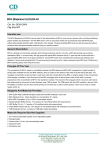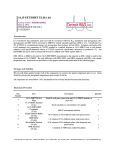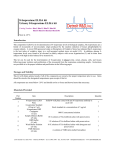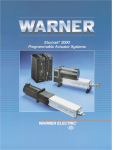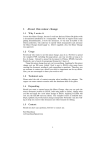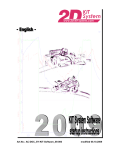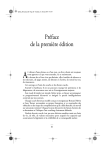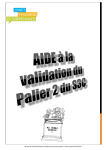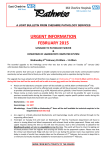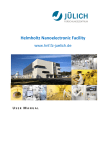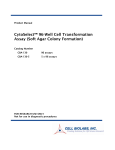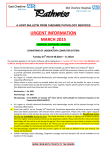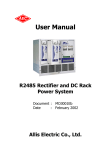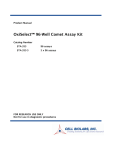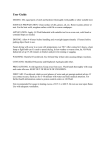Download Product Flyer - Detroit R&D, Inc.
Transcript
Metro Center for High Technology Bldg. 2727 Second Ave. Suite 4113 Detroit, MI 48201 Phone: (313) 961-1606; Fax: (313)963-7130 Email: [email protected] Web: www.DetroitRandD.com Environmental Estrogen ELISA kit Bisphenol A (BPA) Cat # BPA1: ELISA kit for measuring BPA in biological samples, food, wastewater and thermal paper: $272 This competitive ELISA kit is for determination of BPA levels in biological samples, human and animal dietary food, water and wastewater. A typical standard curve of the ELISA (detection limit of less than 10 pg/ml) is shown in the bottom left corner. BPA is a phenolic environmental estrogen1, which disrupts endocrine activity. In human, a BPA glucuronide was the primary metabolite of BPA2. In a recent study, the age group with the highest BPA exposure levels was the 6-11 year old group with a mean total (free + glucuronidated) BPA level of 4.33 ng/g of creatinine3. Urinary BPA levels have 4 been correlated to cardiovascular diseases and diabetes . A recent study revealed that a 12-ounce serving of canned soup for 5 days increased urinary BPA level 12-fold due to lining of the can with an 5 epoxy resin containing BPA . BPA levels in liquid obtained from canned soups (approximately 10 ng/mL) were measured using this ELISA kit6. Each kit can measure the level of BPA for up to 24 triplicate samples and contains one 96 well plate, one vial of BPA standard, one vial of BPA-conjugated HRP, and buffers for sample and BPA-HRP conjugate dilutions, and plate washing. Buy in Quantity and Save! 2-3 kits $258 each; 5-9 kits $245 each; 10 or more kits $231 each Specificity of the BPA ELISA BPA 100% BPF <0.01% BPS <0.01% Resveratrol <0.01% 1. Zhao M, Zhou S, Yan J, Li L. Immunochemical analysis of endogenous and exogenous estrogens. Current Pharmaceutical Analysis (2007) 3, 25-38. 2. Völkel W, Colnot T, Csanády GA, Filser JG, Dekant W. Metabolism and kinetics of bisphenol a in humans at low doses following oral administration Chem Res Toxicol 15, 1281-1287 (2002). 3. Fourth National Report on human exposure to environmental chemicals. Centers` for Disease Control and Prevention (2009) www.cdc.gov/exposurereport. 4. Lang IA, Galloway TS, Scarlett A, et al. Association of urinary bisphenol A concentration with medical disorders and laboratory abnormalities in adults. JAMA. 300, 1303-1310 (2008). 5. Carwile JL, Ye X, Zhou X, Calafat AM, Michels KB. Canned soup consumption and urinary bisphenol A: a randomized crossover trial JAMA. 306, 2218-2220 (2011). 6. Joiakim A, Kaplan D, Friedrich K, Putt D, Kim H. Bisphenol A (BPA) levels in liquid supernatants of canned foods determined by highly sensitive BPA ELISA. Society of Toxicology Abstract #2328 (2013). BPA (Bisphenol A) ELISA kit Catalog Number: BPA1/BPA11/BPA21/BPA101 Store at -20°C. FOR RESEARCH USE ONLY This competitive ELISA kit is for determination of BPA levels in biological samples. A typical standard curve of the ELISA (detection limit of less than 10 pg/ml) is shown on page 6. BPA is a phenolic environmental estrogen1 which disrupts endocrine activity. In human, a BPA glucuronide was a primary metabolite of BPA2. In a recent study, the age group with highest BPA exposure was 6-11 years old with a mean total (free + glucuronidated) BPA level of 4.33 ng/g of creatinine 3. Urinary BPA levels were correlated with cardiovascular diseases and diabetes4. A recent study revealed that a 12-ounce serving of canned soup for 5 days increased urinary BPA level 12-fold due to BPA-containing epoxy resin lining of the cans5. This kit can be used for the determination of BPA in urine, serum, plasma, cells, and tissues following proper isolation and purification and in human and animal dietary foods, water and wastewater. Instructions are provided as to the proper isolation and purification in the following pages. The BPA level in urine or cell culture media can be measured without ethyl acetate extraction after a 4-fold dilution of the sample. This competitive ELISA kit is based on competition between the BPA epitope and the BPA-HRP conjugate for a limited number of anti-BPA antibody binding sites coated on the bottom of the wells of the 96 well ELISA plate. Thus the amount of the BPA conjugate which is able to bind to each of the wells is inversely proportional to the concentration of BPA in the standard or sample. The amount of the conjugate which is bound to each well is then determined by the amount of color obtained when TMB is added. The TMB reacts with the HRP available in the well. With the addition of sulfuric acid, the blue colored product is converted into a yellow colored product, which can be read on a plate reader at 450 nm. Storage and Stability This kit will obtain optimal results if all of the components are stored at the proper temperature prior to use. Items should be stored at the designated temperatures upon receipt of this kit. All components are stored below -20°C and should not be re-frozen and thawed more than necessary. Precautions Please read all instructions carefully before beginning the assay. The reagents in this kit have been tested and formulated to perform optimally. This kit may not perform correctly if any of the reagents are replaced or any of the procedures are modified. This kit is intended for research use only and is not to be used as a diagnostic. Materials Provided Part Number Item Description Quantity 1 BPA ELISA Plate Solid 96-well plate coated with anti-BPA antibody in each well 1 2 BPA Standard (2 μL) Stock standard at a concentration of 1 mg/mL 1 1000 X concentrated solution 1 BPA-HRP Conjugates (12 μL) 3 4 Sample Dilution Buffer (25 mL) 10 X solution of Tris-buffered saline with preservatives 1 5 HRP Buffer (15 mL) 1 X solution of Tris-buffered saline with preservatives 1 6 Wash Buffer Solution (25 mL) 10 X solution of Tris-buffered saline with detergents and preservatives 1 A solution of TMB (tetra methyl benzadine) 1 7 TMB Substrate (24 mL) Additional Required Materials (Not Provided) Plate reader with a 450 nm filter An 8-channel adjustable pipetter and an adjustable pipetter Storage bottles Costar® cluster tubes (1.2 mL) and microcentrifuge tubes Deionized water 2N Sulfuric acid Procedural Notes Remove all of the reagents required, including the TMB, and allow them to equilibrate to room temperature before proceeding with the assay. It is necessary to thoroughly mix the concentrated buffer solutions. A stir bar is contained within each buffer solution. Sample Preparations There are different protocols for isolating BPA depending on the nature of the biological sample. Listed below are the different protocols. For optimal results follow the appropriate protocol. Total BPA measurement in urine, water and wastewater 1. Dilute urine sample 4-fold with 1X sample dilution buffer. Centrifuge diluted urine sample to remove any precipitates. 2. Add 100 L of the sample to a well in the 96-well plate and perform the ELISA for BPA (according to the instructions of the manufacturer). Glucuronidated BPA measurement in urine BPA in human urine is comprised of free BPA and BPA-glucuronide. To convert any glucuronidated BPA to free BPA it is necessary to treat the urine sample with the enzyme beta-glucuronidase. By following this protocol, both free and glucuronidated BPA in human urine samples can be measured. Preparations Make 8.0 mL of a 1.0 M citrate buffer solution, pH 5.5 Dissolve the 8 mg of beta-glucuronidase enzyme provided with the kit in 8.0 mL of the 1M citrate buffer. Centrifuge the urine sample to remove any solids. 1) Dilute 1.0 mL of human urine 4-fold with 1X Sample Dilution Buffer. (You must dilute the 10X Sample Dilution Buffer provided in the kit). 2) Divide the diluted urine sample into two equal aliquots of 0.5 mL 3) Add 0.20 mL of the beta-glucuronidase enzyme solution you prepared ahead of time to one of the diluted 0.5 mL urine aliquots. 4) To the other aliquot, add 0.20 mL the 1M citric acid solution without enzyme. 5) Incubate both aliquots at 37oC for 3 hours (A shaking water bath is recommended). 6) After the three hour incubation add 100 L of the sample to a well of the ELISA plate and follow the instruction provided with the ELISA kit. 7) Subtract the value obtained with the non-glucuronidase sample from the glucuronidase sample to obtain the amount of glucuronidated BPA. 8) Make sure to include all dilution factors in your calculations. BPA measurement in plasma or serum. (If sample is diluted 10 or more fold with sample dilution buffer, the sample can be assayed directly (one-step method). Otherwise follow the protocol below: 1. Combine 1.0 mL of plasma (adjusted with acetic acid to pH 4) and 1.0 mL of ethyl acetate. Vortex thoroughly. Centrifuge at 2000 rpm for ten minutes at 22°C. Three phases should result: i. Upper organic phase – ethyl acetate phase (lipoproteins) ii. Interphase – proteins iii. Lower phase – aqueous phase 2. Collect the upper organic phase (a) and set aside. 3. Discard the interphase. Transfer the lower phase with a glass pipette to a new tube, and repeat the ethyl acetate extraction step 2 more times. 4. Evaporation of pooled organic phase: There should be approximately 3 mL of the ethyl acetate phase (a). Dry the pooled organic phase in a Speedvac to get the extracted sediment (b). 5. Store the sediment (e) at -20°C if performing assay later. For ELISA assay, dissolve the sediment (e) in 20 μL of ethanol, then add 130 μL of 1x Sample Dilution Buffer. 6. For the competitive BPA ELISA, the above 150 μL sample may need to be further diluted. When calculating the concentration, consider any dilution factors. 7. Perform the ELISA for BPA (according to the instructions of the manufacturer). BPA measurement in cells 1. Collect and homogenize and/or sonicate the cells. 2. Acidify the whole homogenized cells with acetic acid to a pH of approximately 3-4. Measure using standard pH paper. 3. Extraction with ethyl acetate. Add an equal volume of ethyl acetate to the homogenized cells and vortex very well. Place the upper organic phase into a fresh clean tube after centrifugation. Then add another equal volume of ethyl acetate to the homogenized cells to start the second-time extraction. It is strongly recommended that extraction is performed three times. 4. Evaporate the pooled ethyl acetate from the extractions until all has dried up under argon or nitrogen gas. 5. Add 10 μL to 20 μL ethanol to reconstitute the dried-up residue from above step #4. Add 0.5 mL of 1x Sample Dilution Buffer (provided in kit). Load 100 μL in each well, in triplicates, on the ELISA plate. (Note: We recommend measuring a different dilution of sample in attempt to fit the results to the standard curve. e.g., add 3 wells with 50 μL of the rest of sample plus 50 μL 1x Sample Dilution Buffer, and 3 wells with 10 μL of the rest of sample plus 90 μL of 1x Sample Dilution Buffer.) 6. Perform the ELISA for BPA (according to the instructions of the manufacturer). BPA measurement in tissues 1. 2. 3. 4. 5. 6. 7. Homogenize 1 g of tissue, 4 mL of H2O. Acidify the homogenate by adding 8 μL of acetic acid to each homogenate. Extract with an equal amount of ethyl acetate, vortex thoroughly, spin down, and collect the organic phase. Repeat this extraction twice more and combine all of the organic phases. Dry the organic phase with argon or nitrogen gas. Dissolve the dried residue from above step #4 with ethanol. Add approximately 20 μL of ethanol or DMF to reconstitute the dried-up residue.) Dilute further with 1x Sample Dilution Buffer: Add approximately 0.5 mL of 1x Sample Dilution Buffer and centrifuge at 10,000 rpm for five minutes at room temperature. The supernatant will be used for ELISA. Perform the ELISA for BPA (according to the instructions of the manufacturer). BPA measurement in canned foods BPA in liquid of human canned food can be measured by the following protocol. 1. Strain liquid portion from any solids 2. Measure volume of liquid (or weigh) 3. Transfer liquid to centrifuge tube and spin at 1000g for 4 minutes at 4 oC to remove any remaining solids. 4. Save supernatant 5. Dilute supernatant 4-fold (more or less dilution may be required) and add 100 uL of sample to well of ELISA plate. 6. Perform ELISA as described in Instruction Booklet provided with kit BPA measurement in animal chow 1. Weigh out 6.5 g of each lab chow 2. Pulverize lab chow with porcelain mortar and pestle 3. Placed in 50 mL tubes and added 10 mL HPLC grade water to powdered lab chow 4. Vortex vigorously for 30 seconds 5. Place on platform rocker and shake for 1 hour 6. Sonicate for 20 seconds at 80% full power 7. Vortex vigorously 8. Remove 2.0 mL to new tube 9. Add 3.0 mL of ethyl acetate and vortex 10. Centrifuge at 3000 g for 5 minutes to separate layers 11. Remove 1.0 mL of ethyl acetate layer to new tube 12. Place tubes in a speed vac and evaporate the ethyl acetate to dryness (45 minutes) 13. Suspend dried extract in 20 uL of 100% ethanol (vortex) 14. Add 1.0 mL 1X sample dilution buffer from ELISA kit 15. Vortex vigorously * 16. Dilute 10X with sample dilution buffer 17. Add 100 uL to well of ELISA plate 18. Perform ELISA assay according to instruction booklet *centrifuge if there is any undissolved material Assay Preparations The solid 96-well plate and TMB solution are provided ready to use. The preparations of other assay reagents are detailed below. Wash Buffer: Mix the solution with a stir bar, applying low heat until a clear colorless solution is obtained. Dilute the entire contents of the Wash Buffer Concentrate (25 mL) with 225 mL of deionized water to yield a final volume of 250 mL of 1 X Wash Buffer. This can then be refrigerated for the entire life of the kit. HRP Conjugate: Dilute 1 vial of the BPA-HRP conjugate (0.012 mL) with 12.00 mL of 1 X HRP buffer. One vial makes enough conjugate for one plate. The conjugate must be used the same day and should not be stored for later use. Standards: Label 5 microtubes as Standard 1 through Standard 5. Dilute the entire contents of Sample Dilution Stock buffer (25 mL) with 225 mL deionized water to yield a final volume of 250 mL of 1 X Sample Dilution Buffer. Add 0.9 mL of the Sample Dilution Buffer to the microtubes for Standards 1 to 5. Spin down the enclosed BPA standard vial (2 μL, filled with inert gas) and add 1.998 mL of Sample Dilution Buffer to obtain 2 mL of solution. Label this Standard 6. Add 0.1 mL of the Standard 6 to the microtube labeled Standard 5 and mix thoroughly. Next, add 0.1 mL of Standard 5 into the microtube labeled Standard 4 and mix thoroughly. Continue to serially dilute the standards using 1:10 dilutions for the remaining standards. Samples: Samples can be directly diluted into the 1 X Sample Dilution Buffer if it is in solution. For extracted and dried samples, it is recommended to dissolve the dried-up samples with a minimal amount of ethanol of N, N-dimethyl-formanmide (DMF, 10 μL to 20 μL) and vortex well. Before ELISA assay, add 100 μL of 1 X Sample Dilution Buffer to make the stock sample solution ready for quantification with ELISA. The stock sample solution can be further diluted to a proper range of concentration for ELISA test. Performing the Assay Plate Setup: Each plate must contain a minimum of three blank wells (B L), three maximum binding wells (BO), and a six point standard curve (S1-S6). Each sample should be assayed in triplicate. A suggested plate format is shown below: Standard Dilutions Table Standards No. 6 No. 5 No. 4 No. 3 No. 2 No. 1 BL BL BL B0 B0 B0 1 1 1 2 1 2 1 2 1 3 1 3 1 3 4 1 4 1 4 1 5 1 5 1 5 1 6 1 6 6 1 =BL Final Concentration (pg/mL) 1,000,000 100,000 10,000 1000 100 10 =S1—S6 =BO =Samples Add Sample Dilution Buffer (mL) Serial Dilutions Procedure 1.998 0.9 0.9 0.9 0.9 0.9 2 μL of stock solution. Add 0.1 mL of No. 6 Add 0.1 mL of No. 5 Add 0.1 mL of No. 4 Add 0.1 mL of No. 3 Add 0.1 mL of No. 2 Assay Procedure Step 1: Load 200 microliters of Sample Dilution Buffer into the blank (BL) wells and 100 microliters of Sample Dilution Buffer into the maximum binding (BO) wells. Step 2: Load 100 microliters of each of the standards into the appropriate wells. Step 3: Load 100 microliters of each of the samples into the appropriate wells. Step 4: Load 100 microliters of the diluted BPA-HRP conjugate in the BO wells, the standard wells, and the sample wells. Do NOT add HRP conjugate into the BL wells. Step 5: Incubate the plate at room temperature for two hours. Step 6: Wash the plate three times with 400 microliters of the diluted Wash Buffer per well. Step 7: After the last of the three wash cycles pat the plate dry onto some paper toweling. Step 8: Add 200 microliters of the TMB substrate to all of the wells (including B L wells). Step 9: Incubate the plate at room temperature for 15-30 minutes. Step 10: Add 50 micoliters of 2 N sulfuric acid to all of the wells. Step 11: Read the plate at 450 nm. Calculating the Results Most plate readers provide data reduction software that can be used to plot the standard curve and determine the sample concentrations. If your plate reader does not have this option, then a data reduction program can be used (4 parameter of loglog curve fit). If you do not have these options, the results can be obtained manually as follows: 1. 2. 3. 4. 5. 6. Average the absorbance readings from the blanks and subtract that value from each well of the plate to obtain the corrected readings. (Note: Some plate readers do this automatically. Consult the user manual of your plate reader.) Average the corrected absorbance readings from the B O wells. This is your maximum binding. Calculate the %B/BO for Standard 1 by averaging the corrected absorbance of the two S 1 wells, divide the average by the maximum binding, then multiply by 100. Repeat this formula for the remaining standards. Plot the %B/BO versus the concentration of BPA from the standards using semi-log paper. Calculate the %B/BO for the samples and determine the concentrations, utilizing the standard curve. Multiply the concentrations obtained for each of the samples by their corresponding dilution factor Typical Results The data shown here is an example of typical results obtained using the Detroit R & D BPA ELISA kit. These results are only a guideline, and should not be used to determine values from your samples. The user must run their own standard curve every time. BL wells BO wells = 0.052 = 2.376 Standard Concentration O.D. No. 1 No. 2 No. 3 No. 4 No. 5 No. 6 10 pg/mL 100 pg/mL 1000 pg/mL 10,000 pg/mL 100,000 pg/mL 1,000,000 pg/mL 2.246 1.726 1.001 0.480 0.188 0.139 %B/ BO 94.5 72.6 42.1 20.2 7.9 5.8 Specificity of anti-BPA IgG The specificity of the BPA ELISA was investigated using authentic BPA and a panel of bisphenols and related chemicals. BPA BPF BPS Resveratrol 100% <0.01% <0.01% <0.01% Troubleshooting No color present in standard wells. The HRP conjugate was not added. Redo the assay and add the conjugate at the proper step. The HRP conjugate was not incubated for the proper time. Redo the assay and incubate for the proper time. No color in any wells, including the TA wells. The TMB substrate was not added. Add substrate. The TMB substrate was not incubated for the proper time. Continue incubation until desired color is reached. The color is faint. One or all of the incubation times were cut short. Redo the assay with the proper incubation times. The TMB substrate was not warmed up to room temperature. Redo the assay making sure all reagents are at room temperature. The lab is too cold. Be sure the lab temperature is between 21-27°C and redo the assay. The background color is very high. The TMB substrate has been contaminated. Redo the assay with a fresh bottle of substrate. Scattered O.D. obtained from the sample. Redo assay using an 8-channel pipetman making sure that 8 channels are equal volume while loading. References 1. Zhao M, Zhou S, Yan J, Li L. Immunochemical analysis of endogenous and exogenous estrogens. Current Pharmaceutical Analysis (2007) 3, 25-38. 2. Völkel W, Colnot T, Csanády GA, Filser JG, Dekant W. Metabolism and kinetics of bisphenol a in humans at low doses following oral administration Chem Res Toxicol 15, 1281-1287 (2002). 3. Fourth National Report on human exposure to environmental chemicals. Centers` for Disease Control and Prevention (2009) www.cdc.gov/exposurereport. 4. Lang IA, Galloway TS, Scarlett A, et al. Association of urinary bisphenol A concentration with medical disorders and laboratory abnormalities in adults. JAMA. 300, 1303-1310 (2008). 5. Carwile JL, Ye X, Zhou X, Calafat AM, Michels KB. Canned soup consumption and urinary bisphenol A: a randomized crossover trial JAMA. 306, 2218-2220 (2011). 6. Joiakim A, Kaplan D, Friedrich K, Putt D, Kim H. Bisphenol A (BPA) levels in liquid supernatants of canned foods determined by highly sensitive BPA ELISA. Society of Toxicology Abstract #2328 (2013 Warranty Detroit R&D, Inc., makes no warranty of any kind expressed, or implied, including, but not limited to the warranties of fitness for a particular purpose and merchantability. Detroit R&D, Inc. Metro Center For High Technology Bldg. (MCHT) 2727 Second Ave. Suite 4113 Detroit, MI 48201 Phone: 313.961.1606 Fax: 313.963.7130 E-mail: [email protected] www.DetroitRandD.com









